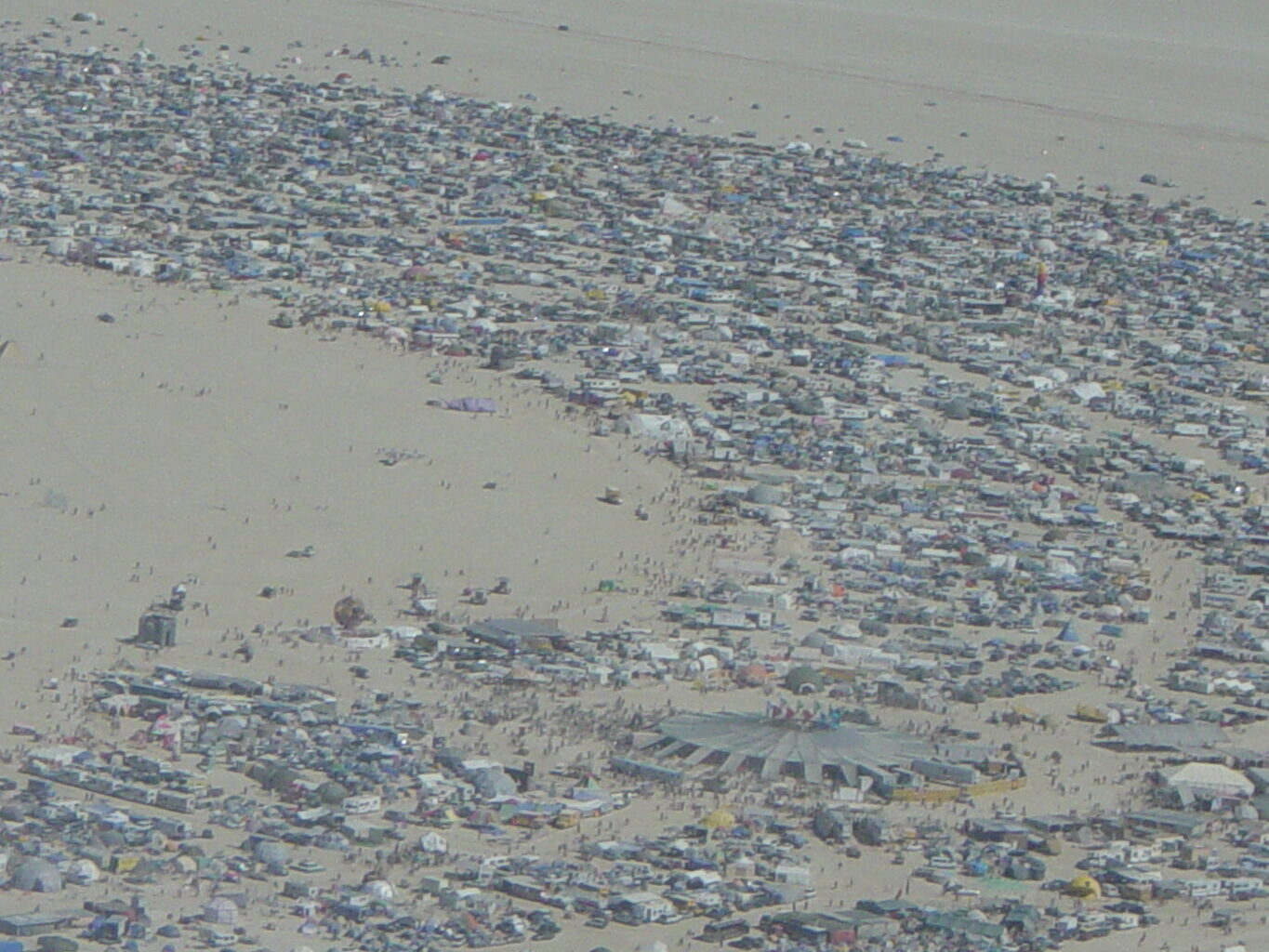
Aerial view of the Burning Man festival in 2003. (Vinay Gupta’s Hexayurt is the 203rd structure in the fourth row to the right of the main tent.) Dave Warner /Mindtel
| Location | Burning Man Festival, Black Rock Desert, Nevada, USA |
| Date | 2001–5 |
In 2001 three distant cousins of the “Bucky Ball” emerged from the desert at Nevada’s Burning Man Festival.
Now over a decade old, the annual event draws 30,000 freethinkers to the Black Rock Desert, where temperatures can soar to over 100 ̊F (38 ̊C) and dust storms and high winds are the norm. To some, this might seem like the last place on earth one would go voluntarily; for emergency shelter designers, it is the perfect location for testing their latest prototype.
The Icosa Pod instantly became an icon at the event, with its futuristic-looking shell and lightweight material. The shelter was designed by Washington-based Sanford Ponder, a musician-turned-Microsoft-executive-turned-designer. In May 2000 he was watching a TV program on homelessness and decided, “If people are living in a box, we need to build a better box.” Sanford went through 200 iterations before settling on the geodesic Icosa. Seventeen months later he was testing his pod under the baking Nevada sun.
He based his design on two main principles: its triangular forms sustain more stress than rectangles and its dome shape provides more usable space. The fi re-retardant, waterproofed laminated-cardboard walls create six-inch- (15-cm-) thick cavities providing passive insulation. In more temperate climates the cavities can be filled with insulation. The pod’s windows are made from UV-resistant Chloroplast, a white translucent plastic with a five-year lifespan.
Since its appearance at Burning Man, the pod has shed its cardboard skin for a more durable laminated-plastic shell and is now being sold at two price points, for retail and humanitarian use. Detractors say that despite the shelter’s tool-free assembly, its number of parts make the time of assembly unfeasible for an emergency situation.
On the other end of the Burning Man spectrum lies Vinay Gupta, who tested his small, low-cost refugee shelter, the Hexayurt, at the festival in 2003.
The Hexayurt is designed to create as little waste as possible in its production. Gupta got the idea while hanging around the Rocky Mountain Institute, where he heard about Strong Angel, a project instigated by the US military to test emergency shelter and communication systems (see below). The design can be built using any four-by-eight-foot (1.2-by-2.4-m) sheet material. Construction requires only six straight cuts across the diagonals of the sheets, to make the roof triangles.
Gupta’s Burning Man prototype was built from Hexacomb cardboard developed by Pactiv Corporation and connected with fiber tape. It was then wrapped in Heatshield, a reflective vapor barrier for insulation and waterproofing developed by Innovative Energy. Separating the structural and waterproofing elements allows for flexibility in the materials used. To handle the area’s extreme heat, Gupta also jimmied an emergency cooling system. A 10-watt solar panel was connected to an improvised swamp cooler, in this instance, a 12-volt computer case fan pulling air through a plastic tub filled with four inches (10 cm) of water. This helped drop the internal temperature even further. In addition to being affordable, the Hexayurt is designed to be lightweight and portable. One adult can carry the hut without difficulty.
However, by far the largest test of relief “ops” carried out during the festival was undertaken by a group of current and former military consultants and personnel. In 2000 US Navy Medical Corps Cmdr. Eric Rasmussen initiated a series of exercises called Strong Angel. The exercises, which are held every few years in Hawaii and involve a wide range of players, including academic, military, and humanitarian relief professionals, are intended to improve coordination between military operations and civilian-led relief efforts around the world. Each year in preparation for these exercises a core team of participants gathers in the desert of Nevada before convening at the official event. Burning Man, with its reputation for attracting free spirits, might be the last place you would expect to see a military base camp. For Rasmussen it was the best austere environment for testing new ideas he had ever seen.
His team had been promoting the idea that the restoration of roads, bridges, ports, water, sanitation systems, shelter, and other basic services could be planned for, practiced, and responded to quickly through better communications networks and the intelligent use of cheap technology. (The group has turned Pringles cans into Wi-Fi antennas, for example.) In 2004 the team erected a geodesic dome (designed by World Shelters, see “Shelter Frame Kit”) at the Burning Man festivities to test the deployment of shelter and communication infrastructure in relief operations.
After Burning Man the team took the Strong Angel operation to Banda Aceh, Indonesia, to assess and support emergency communications infrastructure in the wake of the 2004 tsunami. They found that aid workers were spending time in helicopters surveying areas of the disaster zone that others had already assessed. Had information been shared through a network such as Strong Angel, they could have used the helicopters to transport food and shelter to those in need, Rasmussen noted. He and his team hope to apply Strong Angel’s methodology to future disasters, speeding relief and recovery efforts.















READ OR LEAVE A COMMENT